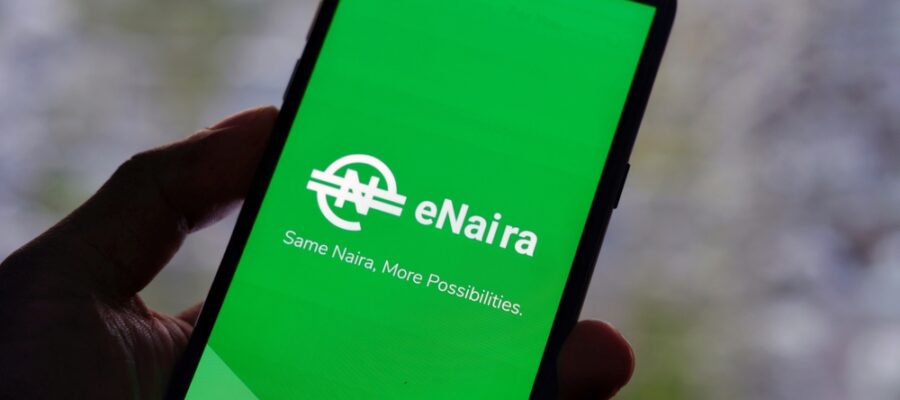A news briefing featured on a media outlet, “The Sun,” revealed the central bank of Nigeria (CBN) has integrated the Near Field Communication (NFC) technology into its digital currency. The development enabled the bank to launch the mobile version of the central bank’s digital currency, dubbed the eNaira.
The NFC upgrade aimed at supporting mobile and payment devices to pair seamlessly. The team behind the upgrade admitted that the development will help the eNaira to provide convenient and reliable payment options.
Central Bank of Nigeria Intregrated NFC Technology on eNaira
News concerning the upgrade came when the Nigerian central bank faced leadership shake-ups after the expulsion of Governor Gowin Emefiele from office. Reportedly Mr. Emefiele remains in police custody for misappropriating funds.
Besides honoring President Bola Tinubu’s order to eject the former governor, the central bank has remained resilient in developing CBDC. The bank announced that integrating the NFC technology aims to support the mainstream adoption of the CBDC.
Before the latest integration of the NFC, the central bank launched QR codes on the CBDC. The development has captivated the public interest demanding more information about the significance of integrating NFC into the eNaira.
In a press release, the deputy director of risk management Joseph Angaye admitted that the CBN plans to leverage innovative technology to boost the user experience. The executive mentioned that the eNaira would have interesting programmable capabilities that surpass user expectations. Angaye explained that the proposed programmable elements of the CBDC aim to reduce the risk of losses by restricting CBDC payment to only government-sponsored platforms.
Addressing the risk management technique adopted by the CBN, Angaye confirmed that the bank would heavily invest in adopting revolutionary technologies, including programmable features. By strengthening the programmability of the CBDC, the bank will be able to allocate funds to farmers more effortlessly. Also, a programmable CBDC will support the CBN in executing core objectives, including acquiring infrastructures.
Nigeria CBDC Experiences Slow Adoption Rate
Reflecting on the press release, Anyange elaborated that the programmability of the CBDC ensures that the funds transferred through the eNaira are used to complete the intended purpose. And, funds locked in the eNaira wallets cannot be diverted for other purposes.
Besides the programmability of the CBDC, the executive outlined the numerous benefits of CBDC. Anyage observed that CBDC expedites the transaction process and reduces settlement risks in the retail sector.
Furthermore, Anyage affirmed that the CBDC aims to improve financial inclusivity in Nigeria. Adopting the eNaira in the West African country will allow other countries to emulate Nigeria when developing their CBDC.
In 2021 the CBN launched the eNaira, aiming at providing the public with a secure and fast payment option. Since then, the CBN has teamed up with other regulatory agencies to increase the usage of CBDC. Even though the CBN efforts have not yielded the desired results, the banks continue to explore ways to improve the adoption rate.
A few months ago, the CBN launched eNaira and USSD in the transport sector, aiming at improving the use case. After introducing the eNaira in the transport industry, the CBDC experienced low adoption. The undesired outcome of CBDC adoption tasked the CBN with new assignments in examining ways to expand the use case of the eNaira.
In an earlier announcement, the outgoing CBN governor lamented that the Nigerian commercial banks have limited the adoption of the eNaira. He stated that commercial banks have prioritized implementing revenue-generating projects rather than suporting the adoption of the eNaira.
Editorial credit: Poetra.RH / Shutterstock.com
All trademarks, logos, and images displayed on this site belong to their respective owners and have been utilized under the Fair Use Act. The materials on this site should not be interpreted as financial advice. When we incorporate content from other sites, we ensure each author receives proper attribution by providing a link to the original content. This site might maintain financial affiliations with a selection of the brands and firms mentioned herein. As a result, we may receive compensation if our readers opt to click on these links within our content and subsequently register for the products or services on offer. However, we neither represent nor endorse these services, brands, or companies. Therefore, any disputes that may arise with the mentioned brands or companies need to be directly addressed with the respective parties involved. We urge our readers to exercise their own judgement when clicking on links within our content and ultimately signing up for any products or services. The responsibility lies solely with them. Please read our full disclaimer and terms of use policy here.

